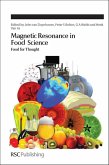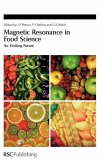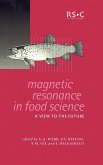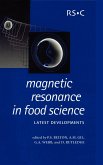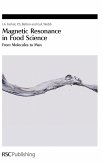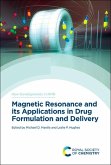Magnetic Resonance in Food Science
Challenges in a Changing World
Herausgeber: Guðjónsdóttir, María; Webb, G A; Belton, Peter S
Magnetic Resonance in Food Science
Challenges in a Changing World
Herausgeber: Guðjónsdóttir, María; Webb, G A; Belton, Peter S
- Gebundenes Buch
- Merkliste
- Auf die Merkliste
- Bewerten Bewerten
- Teilen
- Produkt teilen
- Produkterinnerung
- Produkterinnerung
The term magnetic resonance covers a wide range of techniques, spectroscopy, relaxation and imaging. In turn, these areas are evolving and leading to various new applications of NMR and ESR in food science and nutrition. This book is part of the continuing series of proceedings of the biennial conferences on applications of magnetic resonance to food science. The aim of the book is to bring the reader up to date with the state of the art of the subject by covering a broad range of topics, including sensory science, authenticity, functionality, solid state methods and new methods. With…mehr
Andere Kunden interessierten sich auch für
![Magnetic Resonance in Food Science Magnetic Resonance in Food Science]() Magnetic Resonance in Food Science144,99 €
Magnetic Resonance in Food Science144,99 €![Magnetic Resonance in Food Science Magnetic Resonance in Food Science]() Magnetic Resonance in Food Science126,99 €
Magnetic Resonance in Food Science126,99 €![Magnetic Resonance in Food Science Magnetic Resonance in Food Science]() WebbMagnetic Resonance in Food Science110,99 €
WebbMagnetic Resonance in Food Science110,99 €![Magnetic Resonance in Food Science Magnetic Resonance in Food Science]() BeltonMagnetic Resonance in Food Science114,99 €
BeltonMagnetic Resonance in Food Science114,99 €![Magnetic Resonance in Food Science Magnetic Resonance in Food Science]() EngelsenMagnetic Resonance in Food Science126,99 €
EngelsenMagnetic Resonance in Food Science126,99 €![Magnetic Resonance in Food Science Magnetic Resonance in Food Science]() Magnetic Resonance in Food Science124,99 €
Magnetic Resonance in Food Science124,99 €![Magnetic Resonance and Its Applications in Drug Formulation and Delivery Magnetic Resonance and Its Applications in Drug Formulation and Delivery]() Magnetic Resonance and Its Applications in Drug Formulation and Delivery223,99 €
Magnetic Resonance and Its Applications in Drug Formulation and Delivery223,99 €-
-
-
The term magnetic resonance covers a wide range of techniques, spectroscopy, relaxation and imaging. In turn, these areas are evolving and leading to various new applications of NMR and ESR in food science and nutrition. This book is part of the continuing series of proceedings of the biennial conferences on applications of magnetic resonance to food science. The aim of the book is to bring the reader up to date with the state of the art of the subject by covering a broad range of topics, including sensory science, authenticity, functionality, solid state methods and new methods. With contributions from international experts, this book is essential reading for academics and industrialists in food science.
Produktdetails
- Produktdetails
- Verlag: RSC Publishing
- Seitenzahl: 280
- Erscheinungstermin: 3. April 2009
- Englisch
- Abmessung: 236mm x 160mm x 20mm
- Gewicht: 567g
- ISBN-13: 9780854041176
- ISBN-10: 0854041176
- Artikelnr.: 26376067
- Herstellerkennzeichnung
- Libri GmbH
- Europaallee 1
- 36244 Bad Hersfeld
- gpsr@libri.de
- Verlag: RSC Publishing
- Seitenzahl: 280
- Erscheinungstermin: 3. April 2009
- Englisch
- Abmessung: 236mm x 160mm x 20mm
- Gewicht: 567g
- ISBN-13: 9780854041176
- ISBN-10: 0854041176
- Artikelnr.: 26376067
- Herstellerkennzeichnung
- Libri GmbH
- Europaallee 1
- 36244 Bad Hersfeld
- gpsr@libri.de
PS Belton is Professor of Chemistry at the University of East Anglia and is a former Deputy Director of the Institute of Food Research, UK. M Gudjonsdottir is a Chemical Engineer and Project Manager at Matis' Process Development Department. GA Webb is based at the Royal Society of Chemistry in London. He has edited about 130 volumes, mostly concerned with magnetic resonance studies.
New Techniques; Chapter 1: High resolution NMR analysis of complex
mixtures; Chapter 2: The quantitative impact of water suppression on NMR
spectra for compositional analysis of alginates; Chapter 3: NMR-based
metabonomics approaches for the assessment of the metabolic impact of
dietary polyphenols on humans; Chapter 4: 1H HR MAS NMR: profiling
metabolites in single cereal kernels (of wheat and barley); Chapter 5;
Microstructure investigation of concentrated dairy gels by real-time NMR
diffusion experiments; Chapter 6: Developments in time domain and single
sided NMR; Chapter 7: Investigation of sodium ions in cheeses by Na NMR
spectroscopy; Chapter 8 Applications of field cycling relaxometry to food
characterization; Chapter 9; A low resolution 1H NMR study to investigate
the protective mechanism of sorbitol during vacuum drying of a probiotic
micro-organism; Chapter 10: A low-field-NMR capillary rheometer; Chapter
11: Development of a rheo-NMR system to study the crystallisation of bulk
lipids under shear flow; Chapter 12: NMR-based Multi Parametric Quality
Control of Fruit Juices; Food Systems and Processing; Chapter 13: Effect of
soy addition on microwavable parbaked frozen doughs; Chapter 14:
Identification and quantification of phosphorus in cheeses - methodological
investigations by solid-state 31P NMR spectroscopy; Chapter 15: Using MRI
to study tomato fruit; Chapter 16: SNIF-NMR and chemometric methods applied
to 1H NMR in the study of brazilian brandy authenticity; Chapter 17:
Identification and quantification of major triacylglycerols in selected
South African vegetable oils by 13C NMR spectroscopy; Chapter 18: Pomodoro
di pachino: an authentication study using 1H-NMR and chemometrics -
protecting its P.G.I. European certification; Chapter 19: 1D and 2D 1H-NMR
analysis of taste compounds extracted from raw or fried Allium Cepa l.
Tissues. Methodological questions; Chapter 20: Analysis of butter and
margarine by high-resolution 1H NMR; Chapter 21: Spin-lattice relaxation
time measurements as a probe for triacylglycerol polymorphism and crystal
size; ESR and Other Techniques; Chapter 22: ESR for food irradiation
detection; Chapter 23: Applications of CW-EPR in food quality control and
R&D; Chapter 24: Application of electron spin resonance to study food
anitoxidative and prooxidative activities; Chapter 25: Water/biopolymer
interactions: comparison of NMR with other techniques; Fish and Meat;
Chapter 26: Low field NMR study on wild and farmed atlantic cod (Gadus
Morhua); Chapter 27: A look at NMR relaxometry applications in meat science
- recent advances in coupling NMR relaxometry with spectroscopic,
thermodynamic, microscopic and sensory measurements; Chapter 28: Sodium MRI
as a tool for optimization of salting processes
mixtures; Chapter 2: The quantitative impact of water suppression on NMR
spectra for compositional analysis of alginates; Chapter 3: NMR-based
metabonomics approaches for the assessment of the metabolic impact of
dietary polyphenols on humans; Chapter 4: 1H HR MAS NMR: profiling
metabolites in single cereal kernels (of wheat and barley); Chapter 5;
Microstructure investigation of concentrated dairy gels by real-time NMR
diffusion experiments; Chapter 6: Developments in time domain and single
sided NMR; Chapter 7: Investigation of sodium ions in cheeses by Na NMR
spectroscopy; Chapter 8 Applications of field cycling relaxometry to food
characterization; Chapter 9; A low resolution 1H NMR study to investigate
the protective mechanism of sorbitol during vacuum drying of a probiotic
micro-organism; Chapter 10: A low-field-NMR capillary rheometer; Chapter
11: Development of a rheo-NMR system to study the crystallisation of bulk
lipids under shear flow; Chapter 12: NMR-based Multi Parametric Quality
Control of Fruit Juices; Food Systems and Processing; Chapter 13: Effect of
soy addition on microwavable parbaked frozen doughs; Chapter 14:
Identification and quantification of phosphorus in cheeses - methodological
investigations by solid-state 31P NMR spectroscopy; Chapter 15: Using MRI
to study tomato fruit; Chapter 16: SNIF-NMR and chemometric methods applied
to 1H NMR in the study of brazilian brandy authenticity; Chapter 17:
Identification and quantification of major triacylglycerols in selected
South African vegetable oils by 13C NMR spectroscopy; Chapter 18: Pomodoro
di pachino: an authentication study using 1H-NMR and chemometrics -
protecting its P.G.I. European certification; Chapter 19: 1D and 2D 1H-NMR
analysis of taste compounds extracted from raw or fried Allium Cepa l.
Tissues. Methodological questions; Chapter 20: Analysis of butter and
margarine by high-resolution 1H NMR; Chapter 21: Spin-lattice relaxation
time measurements as a probe for triacylglycerol polymorphism and crystal
size; ESR and Other Techniques; Chapter 22: ESR for food irradiation
detection; Chapter 23: Applications of CW-EPR in food quality control and
R&D; Chapter 24: Application of electron spin resonance to study food
anitoxidative and prooxidative activities; Chapter 25: Water/biopolymer
interactions: comparison of NMR with other techniques; Fish and Meat;
Chapter 26: Low field NMR study on wild and farmed atlantic cod (Gadus
Morhua); Chapter 27: A look at NMR relaxometry applications in meat science
- recent advances in coupling NMR relaxometry with spectroscopic,
thermodynamic, microscopic and sensory measurements; Chapter 28: Sodium MRI
as a tool for optimization of salting processes
New Techniques; Chapter 1: High resolution NMR analysis of complex
mixtures; Chapter 2: The quantitative impact of water suppression on NMR
spectra for compositional analysis of alginates; Chapter 3: NMR-based
metabonomics approaches for the assessment of the metabolic impact of
dietary polyphenols on humans; Chapter 4: 1H HR MAS NMR: profiling
metabolites in single cereal kernels (of wheat and barley); Chapter 5;
Microstructure investigation of concentrated dairy gels by real-time NMR
diffusion experiments; Chapter 6: Developments in time domain and single
sided NMR; Chapter 7: Investigation of sodium ions in cheeses by Na NMR
spectroscopy; Chapter 8 Applications of field cycling relaxometry to food
characterization; Chapter 9; A low resolution 1H NMR study to investigate
the protective mechanism of sorbitol during vacuum drying of a probiotic
micro-organism; Chapter 10: A low-field-NMR capillary rheometer; Chapter
11: Development of a rheo-NMR system to study the crystallisation of bulk
lipids under shear flow; Chapter 12: NMR-based Multi Parametric Quality
Control of Fruit Juices; Food Systems and Processing; Chapter 13: Effect of
soy addition on microwavable parbaked frozen doughs; Chapter 14:
Identification and quantification of phosphorus in cheeses - methodological
investigations by solid-state 31P NMR spectroscopy; Chapter 15: Using MRI
to study tomato fruit; Chapter 16: SNIF-NMR and chemometric methods applied
to 1H NMR in the study of brazilian brandy authenticity; Chapter 17:
Identification and quantification of major triacylglycerols in selected
South African vegetable oils by 13C NMR spectroscopy; Chapter 18: Pomodoro
di pachino: an authentication study using 1H-NMR and chemometrics -
protecting its P.G.I. European certification; Chapter 19: 1D and 2D 1H-NMR
analysis of taste compounds extracted from raw or fried Allium Cepa l.
Tissues. Methodological questions; Chapter 20: Analysis of butter and
margarine by high-resolution 1H NMR; Chapter 21: Spin-lattice relaxation
time measurements as a probe for triacylglycerol polymorphism and crystal
size; ESR and Other Techniques; Chapter 22: ESR for food irradiation
detection; Chapter 23: Applications of CW-EPR in food quality control and
R&D; Chapter 24: Application of electron spin resonance to study food
anitoxidative and prooxidative activities; Chapter 25: Water/biopolymer
interactions: comparison of NMR with other techniques; Fish and Meat;
Chapter 26: Low field NMR study on wild and farmed atlantic cod (Gadus
Morhua); Chapter 27: A look at NMR relaxometry applications in meat science
- recent advances in coupling NMR relaxometry with spectroscopic,
thermodynamic, microscopic and sensory measurements; Chapter 28: Sodium MRI
as a tool for optimization of salting processes
mixtures; Chapter 2: The quantitative impact of water suppression on NMR
spectra for compositional analysis of alginates; Chapter 3: NMR-based
metabonomics approaches for the assessment of the metabolic impact of
dietary polyphenols on humans; Chapter 4: 1H HR MAS NMR: profiling
metabolites in single cereal kernels (of wheat and barley); Chapter 5;
Microstructure investigation of concentrated dairy gels by real-time NMR
diffusion experiments; Chapter 6: Developments in time domain and single
sided NMR; Chapter 7: Investigation of sodium ions in cheeses by Na NMR
spectroscopy; Chapter 8 Applications of field cycling relaxometry to food
characterization; Chapter 9; A low resolution 1H NMR study to investigate
the protective mechanism of sorbitol during vacuum drying of a probiotic
micro-organism; Chapter 10: A low-field-NMR capillary rheometer; Chapter
11: Development of a rheo-NMR system to study the crystallisation of bulk
lipids under shear flow; Chapter 12: NMR-based Multi Parametric Quality
Control of Fruit Juices; Food Systems and Processing; Chapter 13: Effect of
soy addition on microwavable parbaked frozen doughs; Chapter 14:
Identification and quantification of phosphorus in cheeses - methodological
investigations by solid-state 31P NMR spectroscopy; Chapter 15: Using MRI
to study tomato fruit; Chapter 16: SNIF-NMR and chemometric methods applied
to 1H NMR in the study of brazilian brandy authenticity; Chapter 17:
Identification and quantification of major triacylglycerols in selected
South African vegetable oils by 13C NMR spectroscopy; Chapter 18: Pomodoro
di pachino: an authentication study using 1H-NMR and chemometrics -
protecting its P.G.I. European certification; Chapter 19: 1D and 2D 1H-NMR
analysis of taste compounds extracted from raw or fried Allium Cepa l.
Tissues. Methodological questions; Chapter 20: Analysis of butter and
margarine by high-resolution 1H NMR; Chapter 21: Spin-lattice relaxation
time measurements as a probe for triacylglycerol polymorphism and crystal
size; ESR and Other Techniques; Chapter 22: ESR for food irradiation
detection; Chapter 23: Applications of CW-EPR in food quality control and
R&D; Chapter 24: Application of electron spin resonance to study food
anitoxidative and prooxidative activities; Chapter 25: Water/biopolymer
interactions: comparison of NMR with other techniques; Fish and Meat;
Chapter 26: Low field NMR study on wild and farmed atlantic cod (Gadus
Morhua); Chapter 27: A look at NMR relaxometry applications in meat science
- recent advances in coupling NMR relaxometry with spectroscopic,
thermodynamic, microscopic and sensory measurements; Chapter 28: Sodium MRI
as a tool for optimization of salting processes



